
The process of introducing new flavors to toddler can be quite an entertaining and at the same time a rather difficult activity. The “Green Pea and Mint Puree” offers the fresh, vivid pea flavor with the slightest smoky, fresh touch of a mint. This deserves to be a top meal because it is simple to prepare and has nutrients that are more important for growth. The green and smooth looking to it makes it interesting to the young persons and is in fact a creative method of increasing portion size of the vegetables.
Health Benefits of Ingredients
Green Peas:
Containing vitamin A, C, K, B group vitamins, dietary fibres and proteins so it has benefit of good vision, immunity, digestion.
Fresh Mint:
Is rich in antioxidants and has more to do with the intestinal canal at least in rats.
Olive Oil:
Is important in supplying the baby’s diet with the healthy fats that are crucial in the baby’s brain development and growth.

Lemon Juice:
Gives a little hint of the vitamin C that has been added to the peas, and just gives that little boost of flavoring to the peas.

Tips As to How the Parents Can Introduce New Foods to Toddlers
1. Blend with Favorites:
Introduce new foods with familiar ones so that a child can be eased into the new foods easier. For instance mix this puree with potato or sweet potato mash.
2. Play with Presentation:
Feeding should be made slightly fun and entertaining through the kind of shapes used on the plates, the colors used in the bowls. The green color which is used to design most of the products is an obvious attractant to the toddlers.
3. Encourage Exploration:
Allow toddlers to put new food in their hands or nose for them to get acquainted with the food before putting it in their mouths. It can make them more curious as well as willing to try this or that due to the sensory exploration.
4. Stay Consistent:
Introduce new foods severally, but avoid making them take them insisting on them taking them. As it has been said many times before, one must endure to implement change, the same goes for acceptance as well.
5. Make Mealtime Fun:
If your child does not want to eat then make it creative and fun for them; they may love hearing a story behind the food on the table. Some people find it appropriate to add some humor in the choice of food they take during a meal.
For Healthy information you may visit Fit 4 You Section
Introducing Solid Foods to Your Child: This is a guide.
Giving your baby solid foods is one of the most adventurous things you will do for your baby. Here are some tips to help you through this journey:Here are some tips to help you through this journey:
1. Start Slow:
It is recommended to start with getting single-ingredient purees first just to determine if there is any food allergy. This is because it enables one to establish any of these sensitivities at the initial stages.
2. Choose the Right Time:
Follow solids around six months but wait to be sure the baby is ready by eyeing food, and can sit with support. Each child is unique in their way, thus one should always pay attention to the child’s signals.
3. Consistency Matters:
Always present new food items in their diet, although the baby may not take them, the texture will rub off when she grows up. Consistency is the way to go if one is to embrace change.
4. Texture Transition:
Gradually start making a transition from creamy and soft foods to more textured forms of foods as the infant gets acquainted with the new type of meals. Having slow changes in the texture of foods would ensure that they get used to the new changes because the change is gradual.
5. Patience is Key:
Multiple tries may be needed before a baby accepts a food that is new to him. Now and then, you should respond positively to the requests without insisting on getting something in return.
6. Create a Routine:
Include new foods during the time when the child is used to taking his/her meals this will avoid confusing the child. Isolation aids in eliminating indecision about what food to eat.
7. Stay Positive:
Food environment should always be relaxed and no fraught with pressure or tension at all. Rewards do not have to misfly or harm a healthy diet by any means, however the concepts of rewards does and can play a role in the health aspect of eating.
8. Model Eating:
Feed your baby with as many foods as you consume in front of them, this makes them have a taste for what they get to see you eating. This can make them more curious and willing to experiment doing and choosing something new all the time.
9. Be Mindful of Allergens:
Try incorporating into the diet usual allergenic foods gradually, and observe any negative changes. This can help you recognize any allergy that you may have to some type of food so that you avoid them from the first instance.
10. Hydration:
In a bid to avoid your baby from becoming dehydrated always give him/her water aside from breast milk or formula. Water is essential for human body and it also helps in proper digestion of the food that is consumed.
The following Green Pea and Mint Puree is a yummy and packed with nutrients and energy for your toddlers which will assist in kicking off their new journey in life. The blend of sweet peas and fresh mint gives both attractive taste and right temperate for little child to eat.
Green Peas, Fresh Mint Leaves.
Dish's Overall Value
This Green Pea and Mint Puree makes a very rich dish in nutrients that vitamins and minerals as well as healthy fats are available. It helps your toddler grow and develops while at the same time, expanding your little one’s taste buds. The fact that this dish is made green and very smooth ensures that children love it and make a point of taking health foods when they are young.

Instructions
-
Cook the Peas
If fresh peas are employed, these have to be blanched in boiling water for 3-4 minutes or until tender. If using frozen peas, again you have to follow the direction shown on the pack. Drain and let cool slightly:
-
Prepare the Mint
Rinse the mint leaves with clean water.
-
Combine Ingredients
Place the peas, fresh mint, olive oil, and if is used lemon juice in a blender or a food processor and mix.
-
Blend Until Smooth
Stir the ingredients together until fully incorporated and then add water if it is too thick.
-
Season and Serve
For children more than one year, one may add enough salt as desired. Feet serve the puree immediately at a safe for the toddler temperature.
Nutrition Facts
- Amount Per Serving
- Calories 80kcal
- % Daily Value *
- Total Carbohydrate 14g5%
- Dietary Fiber 4g16%
- Sugars 4g
- Protein 4g8%
- Vitamin A 700 IU
- Vitamin C 20 mg
- Calcium 20 mg
- Iron 1 mg
* Percent Daily Values are based on a 2,000 calorie diet. Your daily value may be higher or lower depending on your calorie needs.
Note
Recommendations of Agents That Could Help To Improve Taste
1. Steamed Carrots: Provided sweetness and other vitamins to smoothie to give it some balance and add interesting texture.
2. Avocado: For rich texture as well as for increase in healthy fats.
3. Greek Yogurt: Aids in providing protein and an acidic taste to the food.
4. Basil: An herb that one could use instead of the usual companion to peas, to add an entirely different taste.
5. Parmesan Cheese: A good addition to give depth of flavour and a little extra calcium.
Alternative Ingredient Suggestions
1. Snap Peas: As a replacement for green peas to give the taste and consistency as well.
2. Spinach: As for extra greens and iron.
3. Coconut Oil: Rather than olive oil for an instance of a new taste.
4. Sweet Potato: Used for making the food sweeter and have a creamy touch.
5. Broccoli: All of these give something different and additional nutrients with the normal preparation.








